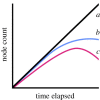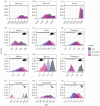Dinosaur diversification rates were not in decline prior to the K-Pg boundary
- PMID: 33391800
- PMCID: PMC7735361
- DOI: 10.1098/rsos.201195
Dinosaur diversification rates were not in decline prior to the K-Pg boundary
Abstract
Determining the tempo and mode of non-avian dinosaur extinction is one of the most contentious issues in palaeobiology. Extensive disagreements remain over whether their extinction was catastrophic and geologically instantaneous or the culmination of long-term evolutionary trends. These conflicts have arisen due to numerous hierarchical sampling biases in the fossil record and differences in analytical methodology, with some studies identifying long-term declines in dinosaur richness prior to the Cretaceous-Palaeogene (K-Pg) boundary and others proposing continued diversification. Here, we use Bayesian phylogenetic generalized linear mixed models to assess the fit of 12 dinosaur phylogenies to three speciation models (null, slowdown to asymptote, downturn). We do not find strong support for the downturn model in our analyses, which suggests that dinosaur speciation rates were not in terminal decline prior to the K-Pg boundary and that the clade was still capable of generating new taxa. Nevertheless, we advocate caution in interpreting the results of such models, as they may not accurately reflect the complexities of the underlying data. Indeed, current phylogenetic methods may not provide the best test for hypotheses of dinosaur extinction; the collection of more dinosaur occurrence data will be essential to test these ideas further.
Keywords: Bayesian; Dinosauria; GLMMs; K-Pg boundary; diversification rates; phylogeny.
© 2020 The Authors.
Conflict of interest statement
We declare we have no competing interests.
Figures



Comment in
-
Strong support for a heterogeneous speciation decline model in Dinosauria: a response to claims made by Bonsor et al. (2020).R Soc Open Sci. 2021 Aug 25;8(8):202143. doi: 10.1098/rsos.202143. eCollection 2021 Aug. R Soc Open Sci. 2021. PMID: 34457325 Free PMC article.
References
Associated data
LinkOut - more resources
Full Text Sources

